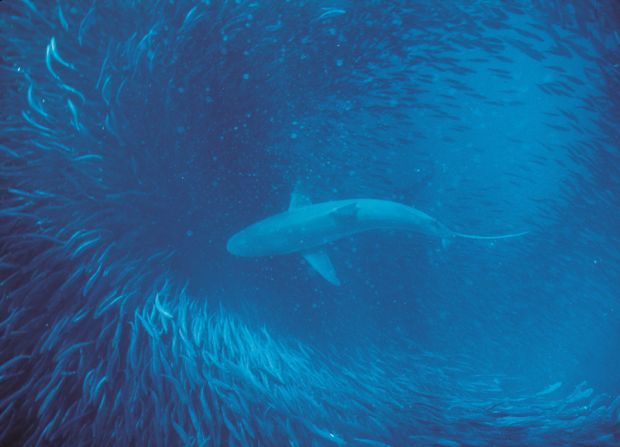Apex predators

Photo: Kennedy Warne.
Apex predators have been in the headlines over this past fortnight, mostly for unfortunate reasons. At the more bizarre end of the spectrum, there were reports of an African lion on the loose in Milwaukee, complete with grainy cellphone video à la Loch Ness monster, but that story was quickly overshadowed by the killing of celebrity lion Cecil by Minnesota dentist Walter Palmer, who, I predict, will not be invited to give a keynote address at any dentistry conventions in the near future.
His actions—luring the lion out of a protected area in Zimbabwe so he could shoot it with a bow and arrow—caused an immediate storm of social media indignation, flaming into vilification. Protesters gathered outside Palmer’s dental practice (which was immediately closed for the duration), holding photographs of the lion with the words “RIP Cecil” and placards bearing the words “I am Cecil” (and some much nastier ones) and leaving stuffed animal toys at the surgery door.
Such was the outcry that one columnist wondered that if every lion was given its own name—and elephants and rhinos, too, while we’re at it—it might engender more public opposition to the killing of big game animals. The disturbing fact is that, according to the IUCN, tourist hunters kill more than 100,000 animals per year, including 800 leopards, 640 elephants and 600 lions. That’s 2% of the wild lion population per year—an unsustainable reduction in a population that is down to about 30,000. Add illegal poaching and the scale of the problem becomes much, much bigger.
One of the apex predators of the sea has also been in the headlines. The weekend before last, a scallop diver in Tasmania became the victim of a great white shark—an awful event that I won’t dwell on.
The shark encounter that really dominated world headlines happened a week before that, in South Africa.
But let me backtrack a moment.
Lately I’ve been writing about mako sharks—the Ferrari of sharks, capable of speeds of 70 km/hr—for New Zealand Geographic, so sharks have been on my mind. Sometimes I think the news media are doing better these days in reporting on shark encounters with humans, pointing out as part of the reporting that it is a million times more common for a shark to be killed by a human than for a human to be killed by a shark, or that large sharks play a crucial role in keeping marine ecosystems in balance, or that they contribute millions of dollars in dive tourism income. But then an incident like the one in Jeffreys Bay happens and it’s Jaws all over again, with narratives of shark-infested waters and mindless eating machines.
So, just to recap, a fortnight ago Australian surfer Mick Fanning had an encounter with a shark while competing in a world surfing championship in South Africa. It was immediately reported around the world (including here in NZ) that he was the victim of a “shark attack” and a “near death encounter.” The thing is, it wasn’t an attack. The surfer wasn’t bitten. The shark swam away.
According to the surfer, the shark (probably a great white) got tangled in the leg rope of his surfboard. Think about that. What is a shark going to do if it finds itself entangled? Thrash around to try and free itself. That’s exactly what happened. It was a big shark, so it had the weight to pull the board out from under the surfer. But there was no attack. The only attacking, in fact, came from the surfer who began pummelling the shark with his fists. A natural enough response, but the shark itself wasn’t doing any attacking.
Sensationalised reporting of this event drew on all the old stereotypes. Apart from describing the incident as an attack, there was the usual trope of “shark-infested waters.” South Africa’s waters are no more “infested” with sharks than African game parks are infested with lions or Kapiti Island is infested with birds. “Infest” is a verb best confined to descriptions of lice, fleas, rats or aphids.
Also, what we didn’t get to hear in the news coverage here was the response of South African surfers such as 30-year veteran surfer and surf instructor Ant Scholte, who gave quite a different perspective, saying: “I have only been lucky enough to see three sharks in all my years of surfing at Muizenberg [a famous surfing beach near Cape Town]. I regard these sightings as an enormous privilege. Seeing them and feeling ‘safe’ in their presence has done wonders for my peace of mind when surfing…. If sharks were even remotely interested in killing/eating humans we would not be able to ever go in the ocean. (Shark attacks would be a daily event). The number of surfers and sharks in Muizenberg are proof that humans and sharks can share the ocean in harmony.”
The central problem is this: If we don’t have a way of thinking and speaking differently about actual predatory incidents—such as the one in Tasmania—and interactions like the one in South Africa, we’ll remain stuck in an unproductive antagonism and a dysfunctional view of the natural world. We can’t hope to improve our dismal record on wildlife extinctions, and the declining fortunes of nonhuman species in general, unless we have a clearer view of human connectedness to nonhuman nature.
I was feeling despondent about the reporting of the Jeffreys Bay incident, but then I came across coverage of a third event involving a great white that happened a week earlier, which put me in a much better frame of mind. Lacking the celebrity news value of a famous surfer, this one fell beneath the threshold for much media coverage.
It happened at Cape Cod, Massachusetts, and involved a great white that beached itself—an uncommon occurrence. It being midsummer, a lot of people were at the beach, and contrary to what you might expect they responded as they would to a beached whale, bringing buckets of water to pour over the shark and phoning the marine department to save the animal. Which is exactly what happened. The videos are lovely—including showing how officials harnessed the shark to the side of their inflatable and cruised slowly around the bay until it had recovered sufficiently to swim off under its own steam. Watch the videos here:
Ryan Daly, a shark researcher I have worked with in South Africa said that after seeing these videos, “I thought people might be seeing sharks as the new dolphins. But there’s nothing like a bit of bad publicity to put your reputation back in the gutter.” He went on to add: “I think the question is, how do we move forward from incidents like the one with Mick Fanning with a more rational approach about human–shark interactions, informed by the knowledge we have today. When Jaws came out we didn’t know sharks were ecologically and economically important, so we could be excused for being irrational. Today there is no excuse.”
Feel healthier! Look younger! Plant a tree!
For at least 30 years, researchers have been reporting the human mental and physical health benefits of trees. Back in 1984, for example, it was reported that patients recovering from surgery were discharged from hospital an average of one day earlier if their room overlooked a stand of trees than if it faced a wall. Since then, researchers have reported links between urban greenspace and improvements in memory and a reduction in aggression and crime. In 2006, a Michigan urban designer identified 22 direct benefits from urban tree planting, and claimed that “for a planting cost of $250-600 (including the first 3 years of maintenance) a single street tree returns over $90,000 of direct benefits in the lifetime of the tree.”
A few weeks ago, research from Canada reported that increasing the number of trees in urban areas could make people feel healthier and reduce cardio-metabolic illness. By analysing responses from more than 31,000 Toronto residents who took an online questionnaire about their health, and comparing those results to a dataset showing the location of the city’s trees, the researchers found that people who live in leafy areas felt healthier and reported fewer stress- and obesity-related conditions such as heart attack, stroke and diabetes than people who live in areas with fewer trees.
Even more interesting is when the researchers applied numbers to the findings. An increase of ten street trees per city block, for instance, increased health perception comparable to increasing the household income by $10,000 or being seven years younger. Adding just one more tree to 11 per block led to a decrease in cardio-metabolic conditions the equivalent to a $20,000 increase in income or being 1.4 years younger.
Photos of trees by Kennedy Warne
Although the study did not identify the mechanisms by which the benefits may occur, the authors suggested that improving air quality, relieving stress and promoting physical activity could all be contributing factors to improved reported health.
One of the things that caught my eye in the Canadian study was that the city of Toronto has mapped and listed all 530,000 trees planted on public land. This reminded me of another story that circulated a few weeks ago about people emailing trees in Melbourne. Melbourne had gone through a similar mapping project to identify and monitor the health of all city trees—some 70,000 of them—giving each tree an ID number and, to make communication more direct, an email address.
Administrators of Melbourne’s urban forest had expected members of the public to report tree-related issues, such as evidence of disease, lack of water or of branches having broken off in storms. What they didn’t expect was the whimsical emails people started sending to trees, everything from thanking them for providing oxygen and beauty to wishing them well in the coming drought. So this is a move beyond the “internet of things” to the “internet of species.”
A further detail in the Toronto study—explored in a commentary in The New Yorker—is that the health benefits of leafiness “stem almost entirely from trees planted along streets and in front yards, where many people walk past them; trees in back yards and parks don’t seem to matter as much.” Perhaps leafy streets encourage people to walk more, but possibly, as in the hospital study, just seeing and being in the presence of trees is therapeutic. And the benefits accrue whether or not you’re a nature-loving person. As the New Yorker article concludes, “Something deep within us responds to the three-dimensional geometry of nature, and that is where arguments of economic equivalence, however well intentioned, fall short. If someone offers you ten thousand dollars or ten trees, take the trees.”

































